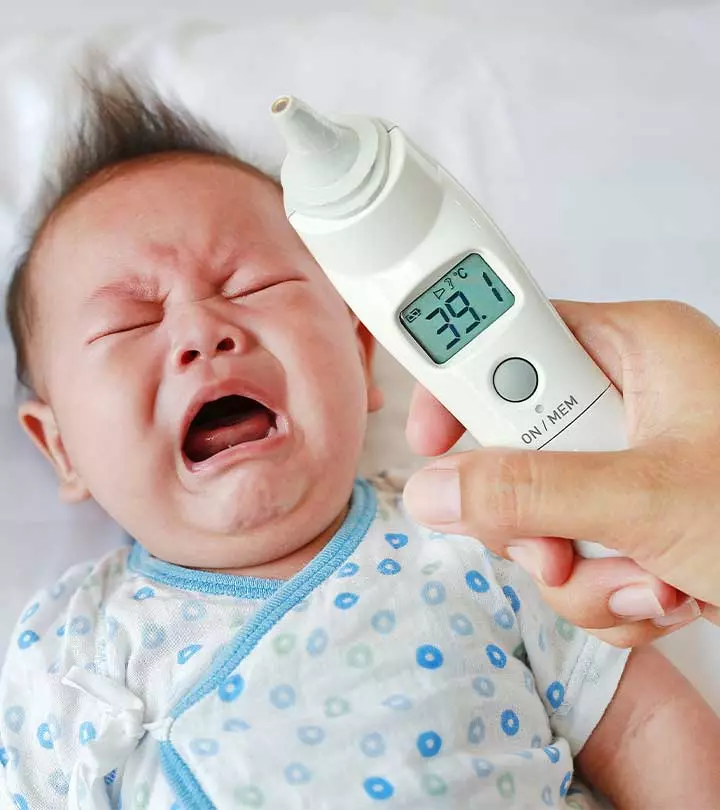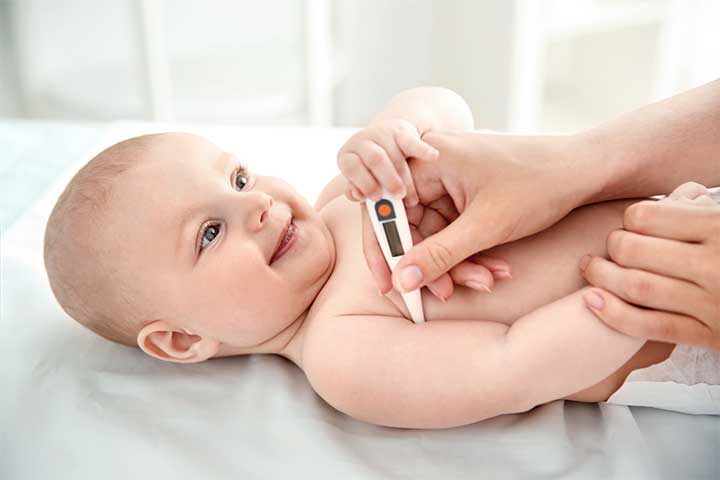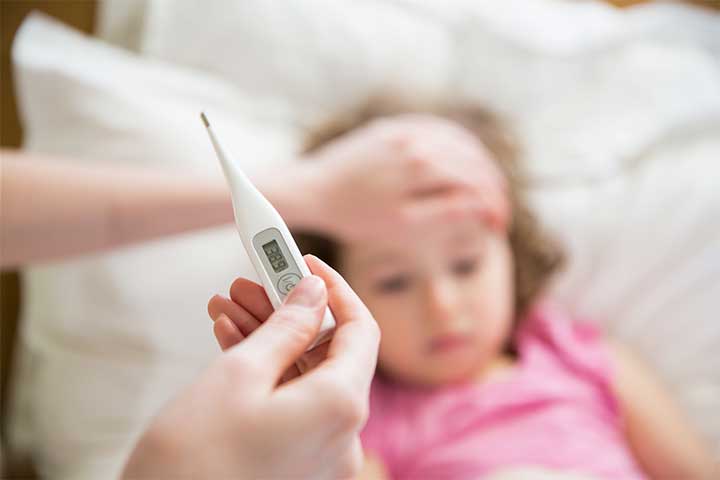
Image: Shutterstock
Navigating the realm of parenthood is a journey of constant learning, and one of the crucial aspects to embrace is accurately taking your baby’s temperature. Since babies can’t articulate their needs verbally, comprehending their cues and vital signs takes center stage. Whether you’re managing a restless baby or aiming to ensure their optimal health, the ability to take your baby’s temperature accurately becomes an indispensable skill. In this article, we’ll lead you through the comprehensive process of measuring your baby’s temperature, covering everything from typical ranges to diverse methods and thermometer options. Read on!
What Is A Normal Temperature For A Baby?
First things first, let’s talk about what constitutes a normal temperature range for babies. A baby’s normal body temperature slightly differs from adults’. The typical range for babies is around 97°F (36.1°C) to 100.3°F (37.9°C) (1). Keep in mind that temperatures might vary slightly throughout the day. Knowing this baseline is essential for recognizing any deviations that might signal an issue.
Temperature Indicating A Fever In A Baby
Image: Shutterstock
A fever is generally considered a body temperature above 100.4°F (38°C) in babies. Fevers are often a sign of the body fighting off an infection. However, remember that a fever isn’t always a cause for alarm; it’s your baby’s natural response to an illness.
Is Low Temperature Serious In A Baby?
On the flip side, low temperatures can also be concerning. If your baby’s temperature drops below 97°F (36.1°C), it could indicate a potential problem. Keep your baby warm, and if you notice their temperature remains low, consult a healthcare professional.
Types Of Thermometers To Use
Image: Shutterstock
There are several types of thermometers available for taking a baby’s temperature, each with its own pros and cons. The most common types include digital rectal thermometers, digital ear thermometers, temporal artery (forehead) thermometers, and axillary (armpit) thermometers. Choosing the right one for your baby’s age and comfort level is essential.
Where Can You Take A Baby’s Temperature?
Babies can’t simply pop a thermometer under their tongues, so where you measure their temperature matters. The three most common places are the armpit, rectum, and forehead.
How To Take An Armpit Temperature
1. Prepare
Have a digital thermometer and a tissue or cloth for wiping ready.
2. Choose The Right Time
Pick a calm moment, like after a nap or feeding, to minimize any fussiness.
3. Position The Thermometer
Place the thermometer probe directly under your baby’s armpit, ensuring skin-to-probe contact.
4. Hold Arm Down
Gently press your baby’s arm against their body to prevent any air gaps.
5. Wait
Keep the thermometer in place for the time specified in its instructions, usually around a minute.
6. Read The Temperature
When the thermometer beeps or completes the measurement, remove it and check the reading.
7. Record The Result
Make note of the temperature in a baby health journal or on your phone for future reference.
8. Comfort Your Baby
Image: Shutterstock
Offer extra cuddles and soothing words after the process to reassure your baby.
How To Take A Rectal Temperature
1. Accuracy for Infants
A rectal temperature is highly accurate for babies under 3 months.
2. Prepare The Thermometer
Apply a bit of petroleum jelly to the thermometer’s tip for smooth insertion.
3. Baby’s Position
Lay your baby on their back.
4. Gentle Insertion
With care, insert the thermometer about half an inch into their rectum. Hold it until it beeps or per device instructions.
5. Secure Hold
Ensure the thermometer is securely held to prevent any accidental movement.
6. Comfort And Reassurance
After taking the temperature, offer your baby comforting cuddles and soothing words.
How To Take A Forehead Temperature
Forehead thermometers are user-friendly and provide a quick reading. Simply swipe the thermometer across your baby’s forehead, following the manufacturer’s guidelines. However, be aware that factors like sweating or a sweaty forehead can affect accuracy.
Taking A Non-Touching Forehead Temperature
Image: Shutterstock
Non-touch forehead thermometers use infrared technology to measure temperature from a distance. Aim the thermometer at your baby’s forehead and press the button. This method is convenient, especially when your baby is sleeping, but accuracy can vary.
Taking A Touch Forehead Temperature
Touch forehead thermometers involve placing the thermometer gently on your baby’s forehead and holding it there for a few seconds. This method is more accurate than non-touch, but it requires some cooperation from your baby.
In a world of rapid advancements, there’s a thermometer to suit every parenting style. Choose the one that aligns with your baby’s comfort level and age.
Taking your baby’s temperature can be a bit nerve-wracking at first, but with practice and the right techniques, you’ll become a pro in no time. Remember that every baby is different, so understanding their baseline temperature and how they’re feeling is extremely important. Be sure to consult your pediatrician if you’re ever in doubt or if your baby’s temperature is causing concern. As a parent, learning to navigate these minor health challenges is all part of the journey. Rest assured, your baby’s well-being is in capable hands – yours. Let us know in the comments your experience with taking your baby’s temperature!
















